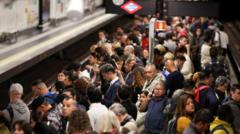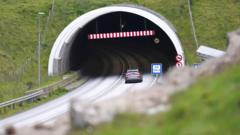Spain faced a massive two-day blackout that prompted questions about its energy infrastructure and response. Following a critical loss of 15 gigawatts of electricity due to simultaneous disconnection incidents, authorities worked tirelessly to restore power, utilizing a combination of renewable energy sources and external aid from neighboring countries. Despite successful recovery efforts, concerns linger about future system vulnerabilities, particularly regarding the integration of solar energy.
Spain's Power Outage: A Test of Resilience and Recovery

Spain's Power Outage: A Test of Resilience and Recovery
After an unprecedented blackout, Spain managed to restore its power grid, raising critical questions about the future of its energy reliance on renewables.
The chaos in Spain this week triggered by an almost 23-hour national blackout has finally subsided, with electricity gradually being restored in most regions, including essential services. The power outage, beginning at 12:33 p.m. on Monday, saw a staggering 15 gigawatts of electricity lost, sparking widespread disruption across the country.
Government officials are now in deep discussions regarding the underlying causes of this failure and the important lessons that must be integrated to prevent a recurrences. Prime Minister Pedro Sánchez pointed to simultaneous disconnection incidents in the southwestern region of Spain as the immediate cause, warning that 60% of the country's generation capabilities vanished.
As investigations continue into the blackout, the director of Red Eléctrica, Eduardo Prieto, confirmed that two disconnection events occurred within a fleeting time span, drastically impacting the grid's stability. Notably, only the Canary Islands, Balearics, and certain coastal areas remained unaffected, indicating the far-reaching consequences of this failure.
Public discourse has turned contentious, with several public figures arguing that the reliance on renewable energy, particularly solar power, contributed to this crisis. Before the outage, around 60% of Spain's energy was generated from solar resources.
By Tuesday, services like the Madrid metro began resuming operations. The recovery process was methodical, as careful management was required to avoid overloading the system, which could lead to another power failure. A focus was placed on hydro-electric sources, with pumped-storage plants being quickly initiated, while gas and remaining nuclear plants were brought back online.
Spain's international energy partners played crucial roles in aiding recovery efforts: Morocco transferred significant power via high-voltage lines, while France progressively supplied electricity back to the Spanish border throughout the crisis.
As power conditions improved, by Monday evening, around 35% of energy demand was restored, rising to over 99% by dawn on Tuesday. Despite the successful restoration efforts, economic impacts are forecasted at around €1.6 billion, fueling political backlash against the government's handling of the situation.
While many Spaniards displayed remarkable resilience, aiding one another and helping maintain order, officials remain cautious. Hospitals managed to keep operational through backup generators, but the emotional toll of the blackout was evident as communication methods dwindled for the general public.
As the dust settles, Sánchez affirmed commitments to ensure that lessons are learned and that future crises can be adequately addressed. Yet, energy experts remain skeptical regarding the infrastructure's capability to handle surges in renewable production, as past warnings about potential vulnerabilities seem more relevant than ever.



















